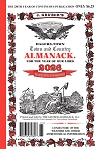Imitators of The Hagerstown Almanack
BUY THE GENUINE ACCEPT NO OTHER
If you have ever received a letter from The Gruber Almanack Company, you might well have noticed the slogan, Buy the Genuine Accept No Other on its envelopes and wondered what it actually meant. In the early years since it’s humble beginnings in 1797, The Hagers-town Town & Country Almanack enjoyed such a degree of popularity in the Mid-Atlantic states that many sought to profit from this popularity by publishing similar, and in some cases, identical almanacs, all claiming to be the "genuine” article. Dr. David L.Green, Professor of English and former Chair of the Humanities Division at Piedmont College, Demorest, Georgia, was intrigued by the official notice from the Court of Appeals of Maryland (appearing in every edition of The Almanack since 1906) and wanted to know the story behind it. He set out to research the history of this decision and has documented them all in a scholarly work entitled, "Almanac (k) Fakery – Imitating Gruber’s Hagerstown Almanack”, soon to be published by the Maryland Historical Society. Dr. Green has graciously agreed to summarize his extensive research and to allow us to include it in our 2006 edition.
J. Gruber’s Hagers-Town Town and Country Almanack is one of only two American almanacs that survive from the 18th century. As early as 1872, the Hagerstown Herald and Torch Light stated that "Gruber’s Almanack . . . told our fathers, our grand and great grand-fathers about the rising and setting of the Sun and Moon, . . . the character of the weather, &c., &c., and it is, therefore, no wonder that we regard it with reverence and cherish it as an heir-loom.” One hundred and thirty-four years later, J. Gruber’s Hagers-Town Town and Country Almanack retains its popularity and continues to make its annual appearance.
In 1854, when he was 86 years old and had published his almanac continuously for 57 years, John Gruber authorized William Stewart of Indianapolis and Thomas G. Robertson of Hagerstown to continue its publication, Stewart to distribute it in the Midwest and Robertson in the east. John Gruber died on 29 December 1857 in his 90th year; his widow, Catherine Gruber, died two years later. In 1858, she had signed a new license, giving the publication rights only to Robertson.
The imitations of the Hagerstown Almanack began in 1859 with Otho Swingley, a Hagerstown shopkeeper and local merchant. John Gruber’s recent death probably led Swingley believe to that the time was ripe to compete with the Gruber almanac. Swingley published the first issue of The New Hagerstown Almanac late in 1859, probably for 1860. It seems to have lasted for only five years—1860 to 1865—an obvious sign that the public wasn't fooled at all.
For more on IMITATORS OF THE HAGERSTOWN ALMANACK, click here


















